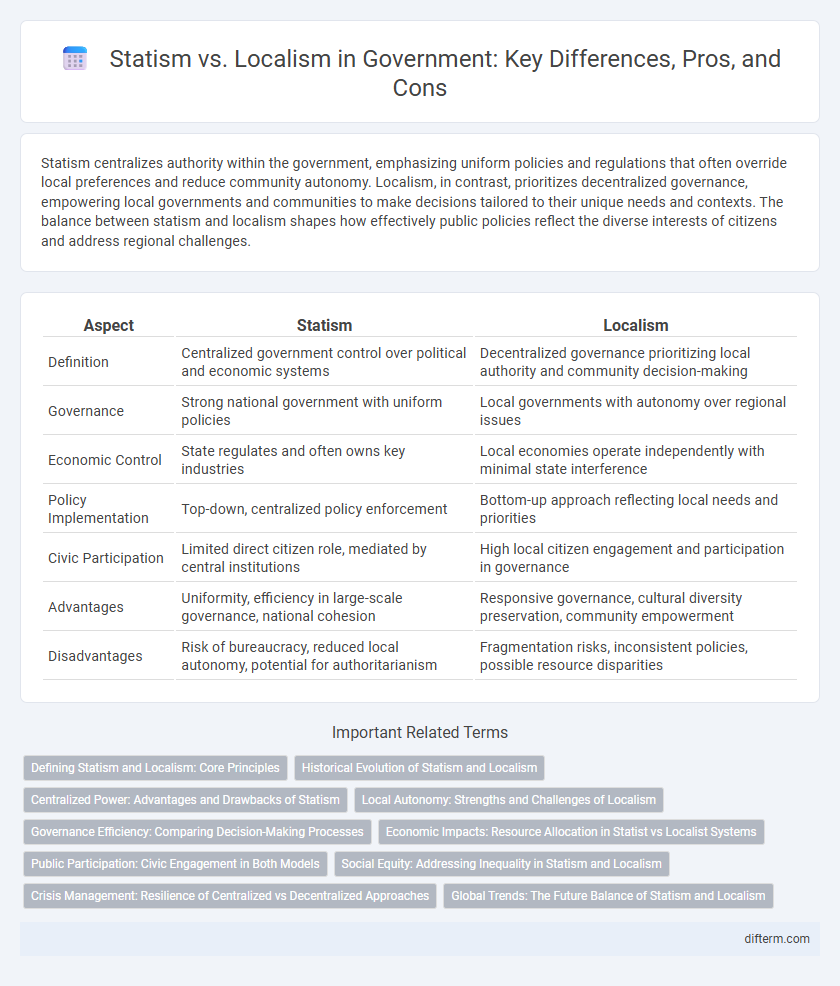Statism centralizes authority within the government, emphasizing uniform policies and regulations that often override local preferences and reduce community autonomy. Localism, in contrast, prioritizes decentralized governance, empowering local governments and communities to make decisions tailored to their unique needs and contexts. The balance between statism and localism shapes how effectively public policies reflect the diverse interests of citizens and address regional challenges.
Table of Comparison
| Aspect | Statism | Localism |
|---|---|---|
| Definition | Centralized government control over political and economic systems | Decentralized governance prioritizing local authority and community decision-making |
| Governance | Strong national government with uniform policies | Local governments with autonomy over regional issues |
| Economic Control | State regulates and often owns key industries | Local economies operate independently with minimal state interference |
| Policy Implementation | Top-down, centralized policy enforcement | Bottom-up approach reflecting local needs and priorities |
| Civic Participation | Limited direct citizen role, mediated by central institutions | High local citizen engagement and participation in governance |
| Advantages | Uniformity, efficiency in large-scale governance, national cohesion | Responsive governance, cultural diversity preservation, community empowerment |
| Disadvantages | Risk of bureaucracy, reduced local autonomy, potential for authoritarianism | Fragmentation risks, inconsistent policies, possible resource disparities |
Defining Statism and Localism: Core Principles
Statism emphasizes centralized government control, where state power directs economic and social policies to maintain order and provide public services. Localism advocates decentralized governance, empowering local communities with autonomy to address unique needs and foster civic participation. Core principles of statism include uniformity and centralized authority, while localism prioritizes subsidiarity and grassroots decision-making.
Historical Evolution of Statism and Localism
The historical evolution of statism reveals a gradual centralization of political power aimed at achieving national unity, economic regulation, and social order, prominently seen during the rise of modern nation-states in the 17th and 18th centuries. In contrast, localism originated from traditional governance structures prioritizing community autonomy and decentralized decision-making, often maintained through local councils and customary law. The ongoing tension between these paradigms reflects the balance between centralized authority and grassroots participation throughout governmental history.
Centralized Power: Advantages and Drawbacks of Statism
Statism centralizes authority within a national government, enabling uniform policy implementation and streamlined decision-making across regions. This centralized power enhances national security, economic coordination, and resource distribution but often risks bureaucratic inefficiency, reduced local autonomy, and slower responsiveness to community-specific needs. Balancing centralized control with local input remains a critical challenge in optimizing governance effectiveness.
Local Autonomy: Strengths and Challenges of Localism
Local autonomy empowers communities to tailor policies and services to their specific needs, fostering innovation and accountability in governance. This decentralized approach enhances civic engagement and responsiveness but faces challenges such as resource limitations and potential disparities in service quality across regions. Balancing local decision-making with coordinated support from higher government levels is crucial for addressing these issues effectively.
Governance Efficiency: Comparing Decision-Making Processes
Statism centralizes authority, enabling uniform policy implementation but often slowing decision-making due to bureaucratic layers. Localism accelerates governance by empowering community-level decision-makers, enhancing responsiveness and tailoring solutions to specific needs. Balancing these approaches influences efficiency, with statism favoring consistency and localism promoting agility in governance processes.
Economic Impacts: Resource Allocation in Statist vs Localist Systems
Statist systems centralize economic decision-making, often resulting in large-scale resource allocation aimed at national priorities but can lead to inefficiencies due to bureaucratic delays and misaligned incentives. Localist systems allocate resources through decentralized governance, enhancing responsiveness to community-specific economic needs and fostering innovation by leveraging localized knowledge and stakeholder engagement. Economic impacts differ significantly as statist models may prioritize uniform development, whereas localist approaches encourage tailored investment, potentially boosting regional economic resilience and diversification.
Public Participation: Civic Engagement in Both Models
Statism centralizes decision-making authority, often limiting public participation to formal channels such as voting and public hearings, which can restrict direct civic engagement. Localism encourages active community involvement by empowering local governments and fostering grassroots initiatives, resulting in higher levels of citizen input and collaborative problem-solving. Research shows that increased public participation in localism strengthens accountability and responsiveness in governance compared to more centralized statist models.
Social Equity: Addressing Inequality in Statism and Localism
Statism centralizes authority to implement broad social equity policies aimed at reducing systemic inequalities through nationwide redistribution and standardized welfare programs. Localism emphasizes community-based approaches, tailoring social equity initiatives to address unique local disparities and empowering grassroots participation in resource allocation. Balancing statism's uniformity with localism's contextual responsiveness is crucial for effectively addressing inequality across diverse populations.
Crisis Management: Resilience of Centralized vs Decentralized Approaches
Centralized crisis management under statism enables rapid resource mobilization and uniform strategy implementation, increasing efficiency in large-scale emergencies. Localism promotes resilience by empowering communities with tailored responses and fostering adaptive capacity based on localized knowledge. Balancing central coordination with decentralized flexibility enhances overall crisis preparedness and recovery outcomes.
Global Trends: The Future Balance of Statism and Localism
Global trends indicate a shifting balance between statism and localism, as decentralized governance gains traction alongside enduring state authority. Increased urbanization and digital connectivity empower local governments to address community-specific needs while states focus on broader policy coordination. The future governance model favors adaptive collaborations that blend centralized regulation with localized autonomy to enhance responsiveness and resilience in public administration.
Statism vs Localism Infographic

 difterm.com
difterm.com